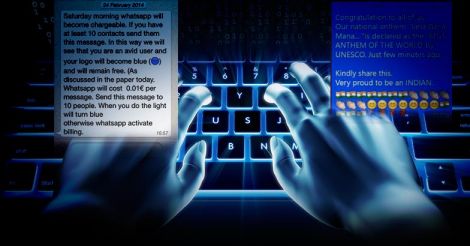“A lie can travel halfway around the world before truth has even finished putting on its shoes” – this legendary quote elegantly illustrates how lies spread faster than the truth.
What is the difference between a lie and a hoax?
A lie is a single incident, used by the liar for personal gain of unfair nature. When a lie captures the attention of a large body of people, sometimes even millions of them, it becomes a case of mass deception and is termed a hoax. As in the case of lying, a hoax is a purposeful act of deceit -- albeit on a larger scale.
A typical example is the Loch Ness monster (Nessie): a fictional underwater creature that is believed by many to live in a lake in Scotland. For centuries, people believed this tale; proving it wrong was difficult due to the size and depth of the lake. After the infamous ‘surgeon’s photograph’ of the monster was published in 1933 (proven later to be a fake), local tourism flourished. Over a million visitors still flock to Loch Ness every year, hoping to get a glimpse of Nessie.
The horror film The Conjuring2, playing in theatres now, is based on a popular British haunting story, widely believed to be an elaborate hoax aimed at garnering public attention.
Read also: Everyday Health | Love Kerala food? Here's a diet plan tailored for you
Everyday health | Learn these 6 first-aid tips, be a lifesaver [ video]
Closer to home, a recent hoax involved the story of a child who allegedly got kidnapped in a Kochi shopping mall. This story was blindly believed and shared by a large number of people on social media. In fact, the same hoax had been circulating in other versions for years, variously involving malls in Gurgaon, Mumbai and even Malaysia.
Many Keralites believe that placing a plastic bottle filled with blue-coloured water on their property will keep stray animals away – an example of a locally brewed but harmless hoax without a specific source or malevolent purpose, which can also be called an urban legend.
This article is about how hoaxes exist all around us, and how we ourselves unwittingly become liars by spreading them. Some recent hoaxes that circulated on WhatsApp and Facebook targeted prominent food manufacturers including Pepsico, KFC, Parle and Cadbury, attempting to malign their products. Though hoaxes commonly involve celebrities, successful businesses or religion, lately, they have involved the field of healthcare.
Everyday Health | Who said death has to be unpleasant? Do these 16 things now
Everyday health | Noise kills: this is scarier than you thought
How do hoaxes spread?
Though the creation of a hoax understandably involves a devious purpose, it is fascinating to study how they spread across the world -- from a psychology perspective. After all, why would seemingly intelligent, educated people engage in spreading lies, with no apparent personal or monetary gain (at least in most cases)?

1. Though most of us tend to have a high opinion of ourselves, there is in fact no limit to human gullibility. The human mind, ever curious, can be tricked into believing almost anything, provided the material is presented in the right format -- take the extreme case of the suicide bomber or the benign street magician, for example. It makes no wonder that a well-crafted hoax can deceive even the sharpest minds.
2. When a person leading a mundane life receives a new piece of information sporting an attractive title and an emotional appeal, he gets tempted to spread it around “in good faith” and savour the momentary attention he might receive from his peers.
3. Hoaxes are truly a worldwide phenomenon, affecting every community in the world. Education, sophistication and intelligence have little to do with it. In fact, the vast majority of reported hoaxes are from the United States.
4. Hoaxes of yesteryear were propagated mostly by word of mouth, and later through email chain letters. With the arrival of social media, they can now be spread at the tap of a fingertip – at no cost to the sender.
5. Most people would not bother to read the whole message or attempt to check its authenticity – as both actions take time and effort. It is easier to hit the ‘send’ or ‘share’ button.
6. When we hear the same thing from multiple sources, we tend to believe it, transforming a lie into perceived truth. Hearing it from a person of influence virtually seals the deal.
7. Confirmation bias: we all love to hear about what we already know. If the story conforms to our belief or desire, we tend to forward it.
8. In a closed social media group, the hoax message might have come from someone who is trustworthy. This tricks others in the group into believing the forwarded message, although the sender did not actually create the message. This process repeats endlessly.
9. Those few people who know that it is a hoax would rather keep quiet about it, to avoid embarrassing the sender who might happen be a senior or a superior at work.
10. In the pre-Internet decades, printed information (newspapers, textbooks and journals) was equated with truth, thanks to dedicated editors who ensured credibility. People from that era might still consider any printed information authentic -- a factor that helps hoaxes spread freely over the Internet.
11. Everybody loves shortcuts. Claims of magical cures, no matter how implausible they may seem, are perpetually in circulation, fuelled by hope.
12. Unlike the case of a lie where the victim is seldom ridiculed by society, a hoax could attract public embarrassment for those who got duped. Victims of hoaxes are thus reluctant to speak up.
13. Most successful hoaxes have one factor in common: it is incredibly hard to prove that they are wrong. For example, it hard to prove that there is no monster in the lake, aliens did not abduct human beings, or that the hair oil failed to deliver its promise.
How to identify a hoax message on social media:
Hoaxes have tell-tale signs, and once we have identified a few, spotting the rest is easy. Many suspected hoaxes can be verified at www.snopes.com for authenticity. The following are dead giveaways:
1. Dramatic self-introduction "Hello, I am Riya, director of Whatsapp, this is to inform all our users that we have only 530 accounts left ", "Cancer update from John Hopkins".
2. Lots of emoticons, exclamation marks, liberal use of words such as “Urgent” “Important” “Warning”, begging us to "please share with all your friends!!!"
3. Scary or patriotic title: “Boy got AIDS by eating pineapple!” “UNESCO has chosen Jana Gana Mana as the best national anthem in the world!” “Keyrings handed out at airports as secret tracking devices!” A partial list is available at http://www.hoaxbusters.org/
Hoaxes in Medicine – the difference between truth-seekers and liars
Modern medicine is a science that has evolved over hundreds of years. Though the prescription of an anti-TNF antibody or placement of a coronary stent might seem easy for doctors of the present, the paths leading to such landmarks were long, arduous and dotted with failures.
Truth emerges one step at a time, sometimes after decades of research and deliberation. To quote an example, although many scientific papers have suggested the benefit of various medications for the treatment of fatty liver in diabetics, none of them are officially authorised for the treatment of the condition at this time -- the subject is still under study.
It is this uncompromising standard of research that gave us modern marvels like open-heart surgery, computers, mobile phones and safe aviation.
Unfortunately, parallel to this painstaking process, there are a few who churn out fake medical information overnight with no scientific patronage, and without conforming to any approved system of healthcare.
Their intent could range from raising easy money, creating mistrust in society for the system, or simply the pursuit of perverse pleasure.
What are some of the common medical hoaxes in Kerala?
1. “Euphorbia plant causes cancer” (It’s a common cactus that yields lasting flowers of assorted colours). The number of people in Kerala who threw this harmless plant out of their garden after believing this hoax is staggering.
2. “Eating pineapple or dates is harmful in pregnancy”: Most doctors in Kerala are so fed up of hearing this hoax that they now fear saying the truth, just in case an unrelated bad outcome happens and they get blamed for it. (Pineapple and dates are perfectly safe during pregnancy)
3. “Vaccination is harmful, and is the result of secret lobbying by American agencies”: The recent rise in diphtheria-related deaths in Kerala from refusal to vaccinate is the result of such malicious propaganda – a hoax that got unquestioningly believed by tens of thousands of people. It is estimated that 1 out of every 3 children in Malappuram district are inadequately vaccinated -- a disgrace for Kerala’s otherwise commendable public health scenario, and a violation of children’s rights. Both WHO and UNICEF advocate universal vaccination, a practice that prevents an estimated 3 million child deaths a year.
4. “Chemmeen puli reduces cholesterol” An unfortunate hoax, this one sent people scrambling to consume large amounts of this light green fruit (commonly used to add flavour to fish curry in Kerala) in a frantic attempt to “naturally reduce cholesterol.” Tragically, many suffered acute renal failure due to oxalate crystals clogging up their kidneys.
5. “Rubbing the skin with a lotion can help reduce body fat”: Easily among the most illogical yet profitable hoaxes in Kerala’s history, this scam not only did not help people lose weight, but fooled a few users into believing that they did, even convincing others to buy the product.
6. “Lakshmitharu leaf and Mullatha fruit cure cancer”: A fading trend now, but this hoax message generated handsome profits for several nurseries across Kerala that sold tree saplings.
7. “Ottamooli” (single-dose) cures for cancer/heart disease/AIDS: People flock to places that promise magical cures, especially after hearing about the futility of modern medical treatment in terminal illness. While the patient can’t be blamed for continuing to look for a potential cure, there is no justification for lying -- essentially giving a false, unsubstantiated promise that raises the hope of a dying man. In India, the drugs and magical remedies Act prohibits such activity.
For any new treatment to be considered legitimate, there is due process. The discovery should be first published in reputed scientific journals, and the results replicated by independent researchers in other countries to eliminate the possibility of error and bias, followed by endorsement from scientific societies.
Medical hoaxes attempt to sabotage this due process. By the time the hoax is debunked, the people who lost their money, or worse -- their loved one -- will seldom complain for fear of public embarrassment, and the scammers would have quietly moved on to their next project.
In summary, hoaxes will continue to come our way, but a blend of common sense, unrelenting respect for truth and acute awareness about this phenomenon will not only help us stay clear of scams, but also retain our credibility.
As the saying goes, if it sounds too good to be true, it probably is.
(The author is a senior consultant gastroenterologist and deputy medical director, Sunrise group of hospitals)
























